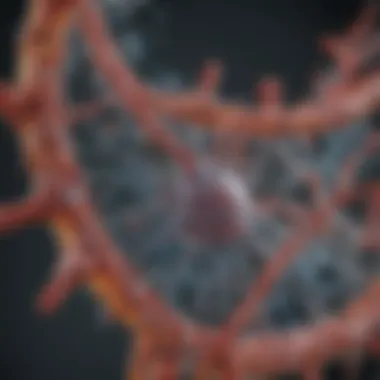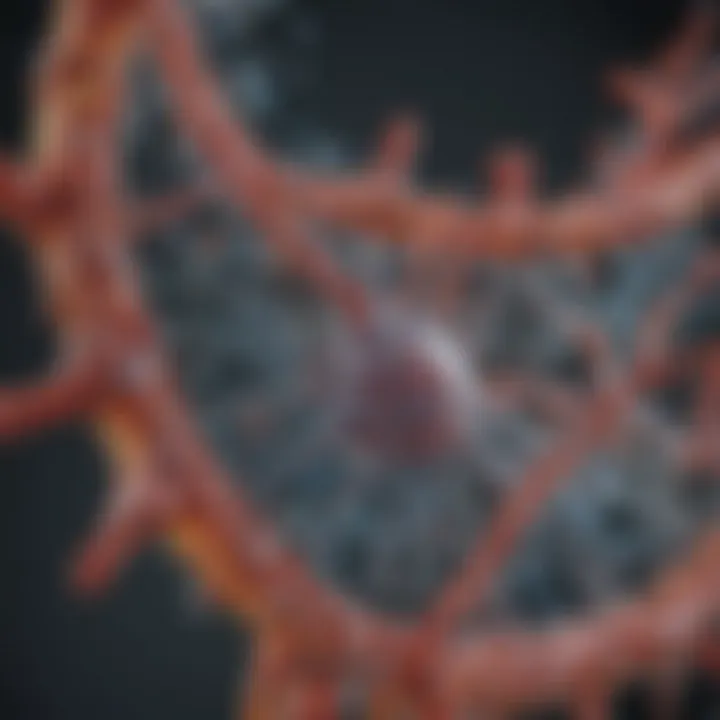Accutase Enzyme: Functions and Applications Explored


Intro
In the realm of biological research and biotechnology, the significance of enzymes cannot be overstated. Among these biological catalysts, a particular enzyme known as Accutase has gained prominence for its unique ability to facilitate cell detachment in various laboratory settings. This enzyme emerges as a valuable tool, particularly in the fields of cell culture and tissue engineering, allowing scientists to manipulate cell behavior with remarkable efficiency. This introduction aims to set the stage for a detailed exploration of Accutase, its mechanistic functions, and its diverse applications, all while connecting its relevance to ongoing scientific conversations.
Accutase functions through a specific enzymatic action, breaking down cell adhesion molecules. But what sets it apart? Unlike other commonly used enzymes, Accutase combines proteolytic activity with the ability to cleave glycosidic bonds, making it especially effective at inducing cell separation without compromising cellular vitality. Its gentle yet effective nature enables researchers to obtain single-cell suspensions ideal for downstream applications such as cryopreservation or high-throughput screening.
Furthermore, the conversation around Accutase is continuously evolving. As research advances, scientists uncover new potentials for this enzyme beyond traditional applications. For example, its impact on stem cell research and regenerative medicine is garnering attention, leading to exciting possibilities in therapeutic developments.
Thus, diving into the nuances of Accutase is not merely an academic exercise—the implications of its functions could lead to significant advancements in biotechnology and medical research. As we proceed with this article, we will dissect its mechanisms of action, experimental methodologies employed, and its future outlook within the scientific community.
Prologue to Accutase
The study of enzymes plays a pivotal role in biochemistry, and among these, Accutase is a particularly interesting subject due to its unique properties and wide applications. Understanding Accutase is crucial, as it bridges the gap between fundamental research and practical application in various fields including cell biology, biotechnology, and regenerative medicine. This section will lay the groundwork for comprehending the significance of Accutase, its role in cellular processes, and how it differentiates itself from other enzymes.
Definition of Accutase
Accutase is a serine protease enzyme renowned for its remarkable ability to detach adherent cells from their substrate without causing significant damage. In the scientific community, it is referred to as an "instruments of cell detachment," while the layman might think of it as a gentle suggestion to cells, asking them to release themselves from the surface. This function is particularly valuable in cell culture where manipulation of cells without harming them is necessary for various experiments and applications.
The enzyme primarily exhibits activity against glycoproteins and can effectively cleave peptide bonds, allowing for the targeted dissociation of cells. The fact that Accutase can perform this task with minimal disruption makes it an indispensable tool in laboratories working with sensitive cell types.
History and Discovery
The origins of Accutase trace back to studies focused on fungal enzymes. Initially, researchers observed the enzyme in a fungal extract that was utilized for cell sorption. This first encounter whetted the appetite for a deeper understanding, leading to further research in the late 20th century when scientists began isolating and characterizing the enzyme’s properties.
As scientists delved deeper, the versatility of Accutase came into sharper focus. Its capability to liberate cells from their anchorage while maintaining cell viability became a talking point in cellular research contexts. Numerous publications emerged throughout the 1990s, documenting not just its enzymatic action, but also its potential implications for cell culture techniques.
A variety of notable milestones have punctuated its history, including the widespread adoption of Accutase as a go-to reagent in laboratory protocols. The enzyme's efficacy compared to traditional methods has prompted countless institutions to invest in its use, reshaping how experiments are designed and executed.
In summary, Accutase is much more than just another enzyme; it represents an innovation in laboratory methodologies that fosters a progressive approach towards cell culture and research. As we venture further into the details of its functions and applications, the understanding of its historical backdrop will enrich our grasp of its current significance.
Biological Mechanisms
Understanding the biological mechanisms of the accutase enzyme reveals its significance not only in research but in various practical applications too. The intricacies of how accutase interacts with cells and substrates lay the groundwork for maximizing its utility in biotechnology and medicine. This section looks into the essential elements—enzymatic activity, substrate specificity, and the cell detachment mechanism—each contributing to a broader picture of accutase's role in both fundamental biology and applied science.
Enzymatic Activity
At the heart of accutase's functionality lies its enzymatic activity. Essentially, this enzyme is classified as a protease, which means it primarily facilitates the breakdown of proteins. It does so through hydrolysis, a process where water molecules are utilized to cleave the peptide bonds in proteins. This action is critical in several biological pathways, particularly in cell culture where cell viability and health hinge on successful enzyme activity.
Accutase exhibits unique characteristics compared to other proteases. For instance, it is especially efficient in cleaving glycoproteins, a particular subset of proteins that have carbohydrate moieties attached. This specificity is crucial when working with cell lines that may depend on glycoproteins for optimal growth and attachment. The fact that accutase operates without harsh conditions, unlike some other enzymes, enables it to retain cell integrity.
Substrate Specificity
Substrate specificity pertains to an enzyme's ability to recognize and interact with particular substrates, and with accutase, this is no different. This enzyme does not just go after any protein; instead, it's selective, targeting specific molecular structures. This means that when preparing cell cultures or conducting research, knowing the precise substrates accutase acts on can dramatically influence the outcomes of experiments.
Some studies indicate that the enzyme has favorable interactions with various cellular components, making it a versatile tool in laboratories. This might include cell surface receptors involved in signaling pathways, a factor that can lead to insights into cell behavior in response to different stimuli. By understanding which substrates are favored, researchers can tailor their protocols to achieve desired results, enhancing the efficiency of cell detachment while minimizing cellular stress.
Cell Detachment Mechanism
Cell detachment is a pivotal process in many research settings, particularly in the context of cell culture and tissue engineering. The mechanism by which accutase detaches cells from a substrate is through the degradation of extracellular matrix (ECM) proteins. The ECM is a complex network of proteins and carbohydrates that provides structural and biochemical support to surrounding cells.
Accutase’s action results in the effective separation of cells while preserving their viability, which makes it particularly beneficial when maintaining primary cultures. This contrasts sharply with more aggressive methods, often leading to cell damage. It's not just about releasing the cells; it's about doing so in a way that keeps them healthy and ready for subsequent experiments.
"The utility of accutase goes beyond mere cell detachment; it’s about nurturing cells for their next phase, whether that be analysis, further culture, or therapeutic applications."


Moreover, the gentle nature of accutase's action plays into the larger narrative of stress reduction in cell culture practices. Thus, its integrative approach to cell detachment supports both the scientific process and the well-being of cellular components, thereby fostering successful research outcomes.
By understanding these biological mechanisms, researchers and professionals can harness the power of accutase enzyme effectively and intelligently, guiding future applications and innovations.
Accutase vs. Other Enzymes
When we measure the potential and utility of Accutase, it's crucial to also consider it in the context of other enzymes commonly used in cellular research and manipulation. Not all enzymes play the same role or function in the same way. Understanding how Accutase stacks up against alternatives provides clarity on why it might be favored in certain scenarios over its counterparts.
Comparison with Trypsin
Trypsin, a serine protease, has long been the go-to enzyme for detaching adherent cells from culture dishes. It cleaves peptide bonds at the carboxyl side of lysine or arginine residues. Though effective, there are notable drawbacks when using Trypsin.
With Trypsin, cells often endure stress, which can disturb their physiological state. This is particularly problematic for sensitive cell types or those that undergo extensive passaging. Here are some bullet points summarizing the differences:
- Cell Viability: Accutase tends to maintain higher cell viability compared to Trypsin, making it ideal for delicate cell lines where survival during passaging is paramount.
- Speed of Action: Trypsin might work too fast, leading to cell fragmentation if not monitored properly. In contrast, Accutase provides a gentler touch, allowing more regulated detachment.
- Enzymatic Specificity: Trypsin has a specific type of action on protein structures. Accutase, however, exhibits broader substrate specificity, breaking down both glycoproteins and proteins, which can be beneficial depending on the experimental setup.
Thus, in scenarios where cell integrity and viability are non-negotiable, Accutase shines, suggesting it as a preferable choice for certain applications.
Alternative Enzymatic Options
Aside from Trypsin, various enzymes vie for attention in the lab when it comes to cell detachment. Some of those alternatives include collagenase, dispase, and elastase, each presenting distinct attributes and drawbacks. While each has its own set of strengths, they come with limitations that sometimes make them less suitable than Accutase.
- Collagenase: Effective for tissues rich in collagen, it facilitates the gentle isolation of cells. However, its effectiveness is highly dependent on the collagen content; thus, there are limits to its use.
- Dispase: Similar to Accutase and often used for primary cell cultures, but it often leads to higher levels of cellular stress, especially in adherent cells.
- Elastase: Primarily cuts elastin rather than general proteins, making it more niche in application.
Ultimately, while other enzymes come to the table with potential benefits, the compounding advantages of Accutase, particularly in preserving cell viability and reducing mechanical damage during passage, make it an appealing candidate in many cellular and tissue engineering applications. > "Accutase not only simplifies the detachment process but also supports the overall health of the cells, setting it apart from the crowd."
In sum, the contrast between Accutase and other enzymes highlights its unique qualities, providing crucial insights into its increasing adoption and growing prominence in cell culture laboratories.
Applications in Cell Culture
The role of accutase in cell culture is nothing short of transformative. As a potent biological tool, it facilitates the growth and maintenance of cells in a laboratory setting. The ability to detach and manipulate cells seamlessly is crucial for a myriad of research applications, and accutase serves as a reliable option. This section will delve into three pivotal features of accutase's application in cell culture: its use in primary cell culture, efficient passaging techniques, and its role in reducing cell stress.
Use in Primary Cell Culture
Accutase is especially useful in primary cell culture due to its gentle yet effective enzymatic action. Unlike traditional methods that may rely on harsher enzymes such as trypsin, accutase enables researchers to maintain cell viability and functionality. This is paramount in studies where primary cells are utilized as they often exhibit specific characteristics that could be compromised through excessive enzymatic treatment.
One of the standout features of accutase is its ability to preserve the membrane integrity of the cells during detachment. This is crucial because damaged membranes lead to altered cellular behaviors and affect experimental outcomes. For example, in neuronal cell cultures, the use of accutase has been reported to ensure higher survival rates and better proliferation compared to other enzymatic options. Thus, when establishing primary cultures, especially from tissues that have delicate cell types, accutase presents a more favorable choice.
Efficient Passaging Techniques
Passaging cells is a fundamental aspect of cell culture, impacting the consistency and quality of experimental results. With accutase, researchers can implement more efficient passaging techniques that minimize cell clumping and enhance cell recovery. Accutase's unique properties allow for a shorter incubation time when detaching cells while still achieving the desired yield.
There are a few techniques to make the best out of accutase during passaging:
- Dilution: Using a diluted solution of accutase can create a more controlled environment, allowing for a gentle release of cells.
- Timing: Monitoring the detachment process is critical. An optimum incubation time typically ranges between 5 to 15 minutes, ensuring the cells detach without prolonged exposure that could cause damage.
- Re-suspension: After detachment, re-suspend the cells gently to prevent shear stress that could lead to loss of viability.
"Using accutase for cell passaging can be like a breath of fresh air in a tightly sealed room—everything just flows better."
Reduction of Cell Stress
Cellular stress is a major concern in cell culture, often leading to undesirable experimental variations. One significant benefit of using accutase lies in its ability to reduce cell stress during the passaging process. By facilitating a gentle dissociation, accutase minimizes the risk of trauma associated with mechanical methods or harsh enzymatic treatments. Studies show that using accutase leads to lower apoptotic rates, which directly correlates with improved cell health and function.
Moreover, the application of accutase can also aid in maintaining the physiological relevance of cell cultures. When cells experience less stress, they are more likely to retain their native characteristics, which is particularly important in applications like drug testing and toxicology assessments.


In summary, the assorted benefits of integrating accutase into cell culture protocols are manifold. From enhancing the establishment of primary cultures to refining passaging techniques and reducing cell stress, it underscores the enzyme’s significance in scientific research. Given the ongoing advancements, it’s evident that accutase is a valuable asset in laboratory settings, promising a future where cell culture methodologies evolve alongside scientific inquiry.
Impact on Tissue Engineering
Tissue engineering is at the forefront of regenerative medicine and biomedical research. It marries the principles of biology, engineering, and material science to develop biological substitutes that restore, maintain, or improve tissue function. Within this innovative domain, the use of enzymes such as accutase plays a pivotal role. Understanding its impact is not just about recognizing a single enzyme's utility; it's about unearthing its significance in optimizing how we interact with cells and scaffolds in tissue constructs.
Role in Scaffold Development
Scaffold development is integral to tissue engineering, providing a framework for cell attachment and growth. Accutase facilitates essential processes in this regard, primarily by supporting the detachment of cells from their native environment without significant harm. It is differentiated from other enzyems, like trypsin, due to its lower impact on cell viability and function.
Importantly, acutase generates a milder proteolytic activity which helps preserve cellular adhesion molecules. These molecules are crucial for maintaining cellular relationships, which subsequently enhance the scaffolding properties.
- Benefits of Using Accutase:
- Minimal cellular damage
- Less dependence on harsh detachment methods
- Maintains essential cellular functions
Moreover, the ability of accutase to promote a more natural cell behavior enhances the overall integrity of the scaffold when used in bioprinting applications. There’s a notable connection between the properties of the scaffold and the type of cells embedded within it. By using accutase to optimize cell seeding techniques, researchers can achieve more robust tissue constructs.
Enhancing Cellular Interactions
Cellular interactions are at the core of effective tissue engineering. It's not merely about placing cells onto a scaffold; it's about fostering a lively environment where cells can communicate, migrate, and proliferate effectively. Accutase's gentle approach to cell detachment encourages this.
When cells are treated with accutase, they retain their expression of key adhesion molecules. This preservation enhances the potential for cells to bond with the scaffold materials. Enhanced cellular interactions lead to improved tissue functionality and integration, which are paramount in achieving desired outcomes in regenerative therapies.
"The scaffold-sculpted environment is not just a passive structure; it is a vibrant ecosystem where cells thrive and communicate."
Understanding how to manipulate these interactions opens the door to ambitious applications of tissue engineering, including the development of engineered organs or advanced wound healing strategies. As we unravel more about the accutase-enriched cellular landscape, opportunities expand for targeted therapies, potentially leading to breakthrough advancements in clinical settings.
Therapeutic Potential
The therapeutic potential of accutase enzyme stands as a beacon in modern biotechnology, particularly in fields such as regenerative medicine and cancer research. Understanding its efficacy and applications can unlock new pathways for treatment and healing, benefiting patients and healthcare providers alike. This section delves into how accutase is utilized in these areas, highlighting its unique advantages and necessity in developing future therapies.
Use in Regenerative Medicine
Accutase has emerged as a foundational tool in regenerative medicine, where its gentle enzymatic properties help in isolating stem cells with minimal damage. In cell-based therapies, particularly those involving stem cells, the ability to detach cells from their culture without compromising their viability is paramount. Traditional methods often involve harsh physical or chemical treatments that can negatively impact cell health. However, accutase provides a more refined approach.
Accutase acts on the adhesion proteins that hold the cells in place. This enzymatic detachment is not only effective but also significantly less stressful for the cells compared to alternative methods. Here are a few key benefits pertaining to its use:
- Enhanced Cell Viability: By minimizing stress during cell dissociation, accutase maintains a higher percentage of viable cells for subsequent applications.
- Multi-Cell Type Compatibility: It is suitable for various cell types, including difficult-to-culture primary cells, significantly broadening research possibilities.
- Applications in Tissue Regeneration: Stem cells isolated using accutase can be directed towards tissue repair, such as cardiac or neural tissues, where precise cell types are crucial for restorative outcomes.
This effective performance in cell detachment fosters diverse applications, from developing new therapies for degenerative diseases to refining approaches for organ transplantation, highlighting the enzyme's role as a critical player in the field.
Implications in Cancer Research
In the realm of cancer research, accutase's application has opened doors to new understandings of tumor biology and cell behavior. Specifically, it facilitates the culture and analysis of tumor cells without the harsh influences that commonly disrupt their natural characteristics.
Utilizing accutase in this landscape has several implications:
- Improved Tumor Cell Isolation: Accutase allows for the precise collection of cancer cells from heterogeneous tumor samples, which is essential for studying their properties and responses to treatments.
- Enrichment of Cancer Stem Cells: These cells may be pivotal in tumor recurrence. By using accutase, researchers can obtain a purer population of cancer stem cells, leading to better insights into their drug resistance mechanisms.
- Studying Metastasis: Accutase enables the examination of cancer cell migration by providing a more realistic environment as these cells can maintain their original morphologies and interactions.
Consequently, the application of accutase in cancer research not only supports better experimental outcomes but also enhances the understanding of treatment resistance, potentially leading to novel therapeutic strategies.
"Accutase offers a gentler touch in the brutal world of cellular experimentation, allowing researchers to delve deeper into the complex behaviors of cells while preserving their integrity."


In summary, the therapeutic potential of accutase is profoundly expansive, particularly in regenerative medicine and cancer research, where improved techniques and methodologies stand to benefit not just the scientific community, but patients in urgent need of innovative therapies.
Challenges and Limitations
Understanding the challenges and limitations surrounding Accutase is crucial for any scholar or practitioner diving into its applications. Despite its wide-ranging benefits in biotechnology and regenerative medicine, there are certain roadblocks that need consideration. These aspects not only impact the practical use of the enzyme but also shape the future of research in this field.
Current Research Gaps
Research on Accutase is still in its infancy. While the enzyme shows great promise, there are notable gaps in understanding its full biological mechanisms. For instance, little is known about the molecular pathways that the enzyme interacts with in various cell types. This lack of clarity can lead to inconsistent outcomes in experimental setups.
Additionally, studies focusing on specific applications,比如 cell detachment in unique tissue types, are scarce. As cell types vary greatly in their biochemical environments, the generalizability of existing research may be limited. More rigorous investigation is needed to elucidate how Accutase affects specifically adapted cancer cells or stem cells used in different assays.
Potential Side Effects
While Accutase is often favored for its gentle action on cells, using it is not without potential downsides. A key concern lies in the enzyme's ability to inadvertently damage some sensitive cell types. For example, its action may lead to alterations in cell morphology or function, especially in highly specialized cells. Such potential side effects demand careful consideration in experimental design.
Moreover, as with any enzymatic treatment, there is the risk of over-application. Prolonged exposure to Accutase could result in unintended consequences, such as influencing cellular signaling pathways or protein expression levels. Therefore, determining the optimal duration and concentration of Accutase in different applications remains a critical area for ongoing research.
"A thorough understanding of limitations ensures proper application of Accutase, leading to more reliable results."
Future Directions of Research
The ongoing exploration of the accutase enzyme signifies an exciting frontier in various fields, particularly biotechnology and molecular biology. Understanding the future directions of accutase research is key to unlocking its full potential, which extends beyond traditional applications. As scientific inquiry advances, it's essential to consider innovative methodologies, a broader scope of research, and the prospects for therapeutic interventions.
Innovative Techniques in Enzyme Application
There’s fertile ground for novel techniques that can enhance the application of accutase. Researchers are now exploring ways to tailor its enzymatic activity to meet specific needs, such as improving efficiency and specificity in cell detachment. Some possible innovations include:
- Genetic Engineering: Modifying the genetic structure of organisms that produce accutase could yield variants with enhanced enzyme characteristics, improving efficiency in cell cultures.
- Nanotechnology Integration: Utilizing nanoparticles could help target accutase delivery to specific cells. This would enhance the enzyme's effectiveness while minimizing potential disruptions to other cell types.
- Microfluidic Systems: The development of microfluidic devices that use accutase in a controlled environment can expedite experimentation by allowing for real-time monitoring of cell behavior as they're detached and processed.
These new techniques not only promote a better understanding of the enzyme's biological functions but also open the door to customized solutions for researchers tackling specific challenges in cell culture and therapy.
Expanding Research Horizons
As the field evolves, there’s an increasing emphasis on broadening the scope of research relating to accutase. This involves both interdisciplinary studies and the exploration of its less conventional applications. Some relevant paths include:
- Applications in Different Organisms: Research could expand to analyze the effects of accutase on various types of tissues across species. Knowing how different environments influence its action could provide deeper insights.
- Synergistic Studies with Other Enzymes: Investigating how accutase interacts with other enzymes in complex biological systems can yield insights that benefit therapies involving multi-enzymatic processes.
- Modeling and Simulation: Utilizing computational models to simulate the interactions accutase undergoes could illustrate its potential therapeutic applications and predict behaviors, thus reducing the time and resources needed for wet lab studies.
Through these expansive research horizons, scientists could not only enhance their understanding of accutase but also innovate its applications in regenerative medicine, cancer therapies, and beyond.
In summary, the future of accutase research appears bright, brimming with possibilities that could significantly impact both fundamental science and practical applications.
Ending
In wrapping up our exploration of the accutase enzyme, it's crucial to reflect on its multifaceted significance within various scientific domains. Accutase’s unique properties not only shine a light on its role in cellular interactions but also underscore its potential in practical applications ranging from cell culture to tissue engineering. This versatility makes it an invaluable tool for researchers, educators, and professionals working in biotechnology and regenerative medicine.
Summarizing Key Insights
- Diverse Applications: Accutase is notable for its ability to facilitate efficient cell detachment, which is foundational for studies in cell culture. Its gentle approach minimizes cell stress, showcasing its superiority compared to traditional methods like trypsinization.
- Biological Mechanisms: The intricate enzymatic activity of accutase, particularly its substrate specificity, provides a window into its functional capacity in biological processes. Understanding these mechanisms deepens our knowledge of cellular functions and their implications in research.
- Therapeutic Potential: With promising applications in regenerative medicine, accutase's role in enhancing cellular interactions presents new avenues for therapeutic developments that could reshape treatment methodologies.
- Current Challenges: While accutase holds significant potential, the challenges surrounding its use—such as potential side effects and gaps in research—must be acknowledged. This caution ensures a balanced perspective when considering its future.
The exploration of accutase has illuminated not only its current applications but also the need for continued research to address unresolved questions and explore uncharted territories of its capabilities.
The Role of Accutase in Future Scientific Endeavors
Looking ahead, the role of accutase within future scientific contexts seems remarkably promising. As researchers continue to delve into innovative techniques for enzyme application, one can envision accutase playing a pivotal role in various studies. Its ability to maintain cellular integrity while aiding in detachment will undoubtedly drive advancements in cell-based therapies and personalized medicine.
Furthermore, expanding research horizons may lead to breakthroughs in understanding how accutase interacts with various cellular substrates, opening up new explorations in cancer research and tissue engineering. As findings emerge, the enzyme could be tailored for specific applications, offering customized solutions to complex biological challenges.
This culmination of insights and future potential positions accutase not just as a mere biological agent, but as a cornerstone for innovative research and development. Unraveling the nuances of its function could yield significant contributions to both theoretical and applied scientific frameworks, emphasizing the enzyme's integral role in future discoveries.

